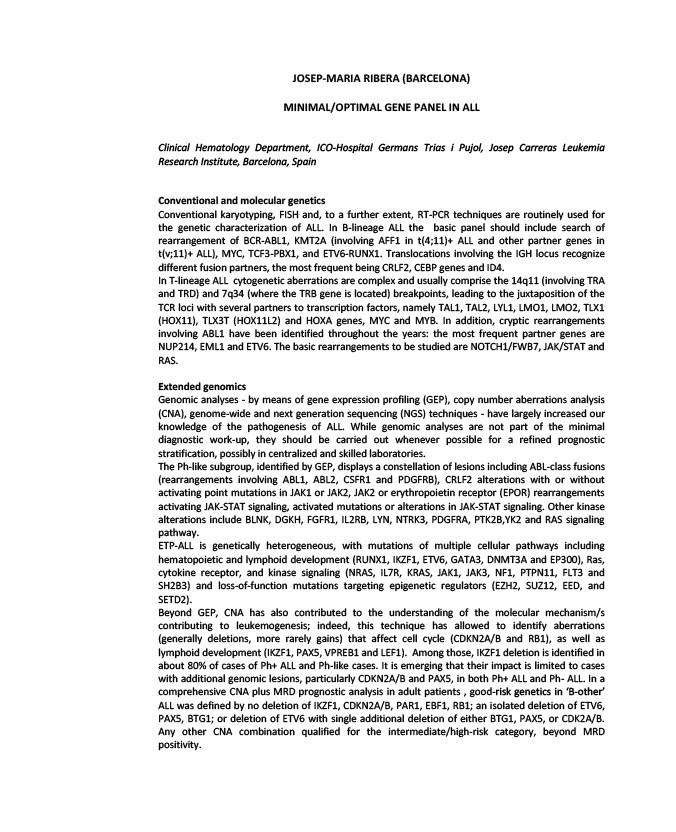
JOSEP-MARIA RIBERA (BARCELONA)
MINIMAL/OPTIMAL GENE PANEL IN ALL
Clinical Hematology Department, ICO-Hospital Germans Trias i Pujol, Josep Carreras Leukemia
Research Institute, Barcelona, Spain
Conventional and molecular genetics
Conventional karyotyping, FISH and, to a further extent, RT-PCR techniques are routinely used for
the genetic characterization of ALL. In B-lineage ALL the basic panel should include search of
rearrangement of BCR-ABL1, KMT2A (involving AFF1 in t(4;11)+ ALL and other partner genes in
t(v;11)+ ALL), MYC, TCF3-PBX1, and ETV6-RUNX1. Translocations involving the IGH locus recognize
different fusion partners, the most frequent being CRLF2, CEBP genes and ID4.
In T-lineage ALL cytogenetic aberrations are complex and usually comprise the 14q11 (involving TRA
and TRD) and 7q34 (where the TRB gene is located) breakpoints, leading to the juxtaposition of the
TCR loci with several partners to transcription factors, namely TAL1, TAL2, LYL1, LMO1, LMO2, TLX1
(HOX11), TLX3T (HOX11L2) and HOXA genes, MYC and MYB. In addition, cryptic rearrangements
involving ABL1 have been identified throughout the years: the most frequent partner genes are
NUP214, EML1 and ETV6. The basic rearrangements to be studied are NOTCH1/FWB7, JAK/STAT and
RAS.
Extended genomics
Genomic analyses - by means of gene expression profiling (GEP), copy number aberrations analysis
(CNA), genome-wide and next generation sequencing (NGS) techniques - have largely increased our
knowledge of the pathogenesis of ALL. While genomic analyses are not part of the minimal
diagnostic work-up, they should be carried out whenever possible for a refined prognostic
stratification, possibly in centralized and skilled laboratories.
The Ph-like subgroup, identified by GEP, displays a constellation of lesions including ABL-class fusions
(rearrangements involving ABL1, ABL2, CSFR1 and PDGFRB), CRLF2 alterations with or without
activating point mutations in JAK1 or JAK2, JAK2 or erythropoietin receptor (EPOR) rearrangements
activating JAK-STAT signaling, activated mutations or alterations in JAK-STAT signaling. Other kinase
alterations include BLNK, DGKH, FGFR1, IL2RB, LYN, NTRK3, PDGFRA, PTK2B,YK2 and RAS signaling
pathway.
ETP-ALL is genetically heterogeneous, with mutations of multiple cellular pathways including
hematopoietic and lymphoid development (RUNX1, IKZF1, ETV6, GATA3, DNMT3A and EP300), Ras,
cytokine receptor, and kinase signaling (NRAS, IL7R, KRAS, JAK1, JAK3, NF1, PTPN11, FLT3 and
SH2B3) and loss-of-function mutations targeting epigenetic regulators (EZH2, SUZ12, EED, and
SETD2).
Beyond GEP, CNA has also contributed to the understanding of the molecular mechanism/s
contributing to leukemogenesis; indeed, this technique has allowed to identify aberrations
(generally deletions, more rarely gains) that affect cell cycle (CDKN2A/B and RB1), as well as
lymphoid development (IKZF1, PAX5, VPREB1 and LEF1). Among those, IKZF1 deletion is identified in
about 80% of cases of Ph+ ALL and Ph-like cases. It is emerging that their impact is limited to cases
with additional genomic lesions, particularly CDKN2A/B and PAX5, in both Ph+ ALL and Ph- ALL. In a
comprehensive CNA plus MRD prognostic analysis in adult patients , good-risk genetics in ‘B-other’
ALL was defined by no deletion of IKZF1, CDKN2A/B, PAR1, EBF1, RB1; an isolated deletion of ETV6,
PAX5, BTG1; or deletion of ETV6 with single additional deletion of either BTG1, PAX5, or CDK2A/B.
Any other CNA combination qualified for the intermediate/high-risk category, beyond MRD
positivity.